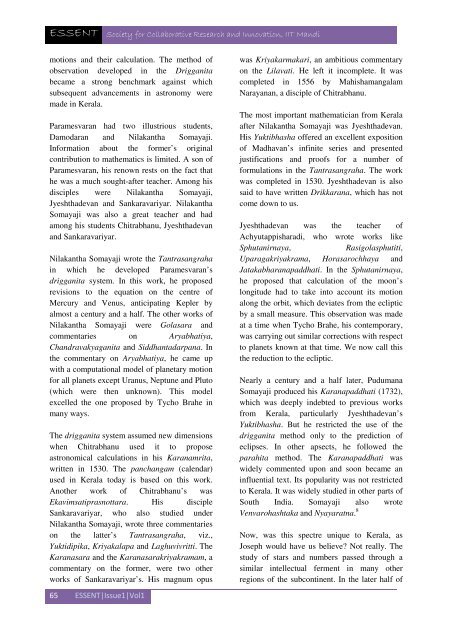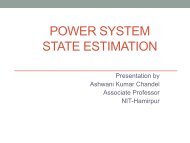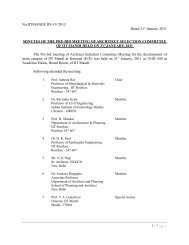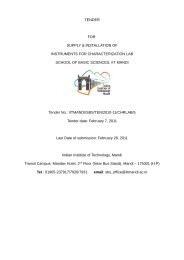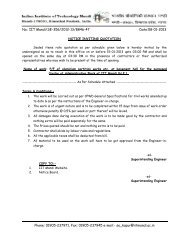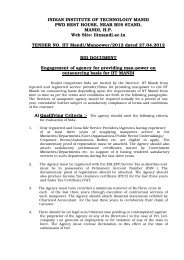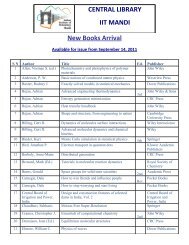Issue1. Vol.1 (April, 2013) - IIT Mandi
Issue1. Vol.1 (April, 2013) - IIT Mandi
Issue1. Vol.1 (April, 2013) - IIT Mandi
- No tags were found...
You also want an ePaper? Increase the reach of your titles
YUMPU automatically turns print PDFs into web optimized ePapers that Google loves.
ESSENT Society for Collaborative Research and Innovation, <strong>IIT</strong> <strong>Mandi</strong>motions and their calculation. The method ofobservation developed in the Drigganitabecame a strong benchmark against whichsubsequent advancements in astronomy weremade in Kerala.Paramesvaran had two illustrious students,Damodaran and Nilakantha Somayaji.Information about the former’s originalcontribution to mathematics is limited. A son ofParamesvaran, his renown rests on the fact thathe was a much sought-after teacher. Among hisdisciples were Nilakantha Somayaji,Jyeshthadevan and Sankaravariyar. NilakanthaSomayaji was also a great teacher and hadamong his students Chitrabhanu, Jyeshthadevanand Sankaravariyar.Nilakantha Somayaji wrote the Tantrasangrahain which he developed Paramesvaran’sdrigganita system. In this work, he proposedrevisions to the equation on the centre ofMercury and Venus, anticipating Kepler byalmost a century and a half. The other works ofNilakantha Somayaji were Golasara andcommentaries on Aryabhatiya,Chandravakyaganita and Siddhantadarpana. Inthe commentary on Aryabhatiya, he came upwith a computational model of planetary motionfor all planets except Uranus, Neptune and Pluto(which were then unknown). This modelexcelled the one proposed by Tycho Brahe inmany ways.The drigganita system assumed new dimensionswhen Chitrabhanu used it to proposeastronomical calculations in his Karanamrita,written in 1530. The panchangam (calendar)used in Kerala today is based on this work.Another work of Chitrabhanu’s wasEkavimsatiprasnottara. His discipleSankaravariyar, who also studied underNilakantha Somayaji, wrote three commentarieson the latter’s Tantrasangraha, viz.,Yuktidipika, Kriyakalapa and Laghuvivritti. TheKaranasara and the Karanasarakriyakramam, acommentary on the former, were two otherworks of Sankaravariyar’s. His magnum opuswas Kriyakarmakari, an ambitious commentaryon the Lilavati. He left it incomplete. It wascompleted in 1556 by MahishamangalamNarayanan, a disciple of Chitrabhanu.The most important mathematician from Keralaafter Nilakantha Somayaji was Jyeshthadevan.His Yuktibhasha offered an excellent expositionof Madhavan’s infinite series and presentedjustifications and proofs for a number offormulations in the Tantrasangraha. The workwas completed in 1530. Jyeshthadevan is alsosaid to have written Drikkarana, which has notcome down to us.Jyeshthadevan was the teacher ofAchyutappisharadi, who wrote works likeSphutanirnaya,Rasigolasphutiti,Uparagakriyakrama, Horasarochhaya andJatakabharanapaddhati. In the Sphutanirnaya,he proposed that calculation of the moon’slongitude had to take into account its motionalong the orbit, which deviates from the eclipticby a small measure. This observation was madeat a time when Tycho Brahe, his contemporary,was carrying out similar corrections with respectto planets known at that time. We now call thisthe reduction to the ecliptic.Nearly a century and a half later, PudumanaSomayaji produced his Karanapaddhati (1732),which was deeply indebted to previous worksfrom Kerala, particularly Jyeshthadevan’sYuktibhasha. But he restricted the use of thedrigganita method only to the prediction ofeclipses. In other apsects, he followed theparahita method. The Karanapaddhati waswidely commented upon and soon became aninfluential text. Its popularity was not restrictedto Kerala. It was widely studied in other parts ofSouth India. Somayaji also wroteVenvarohashtaka and Nyayaratna. 8Now, was this spectre unique to Kerala, asJoseph would have us believe? Not really. Thestudy of stars and numbers passed through asimilar intellectual ferment in many otherregions of the subcontinent. In the later half of65 ESSENT|Issue1|Vol1


